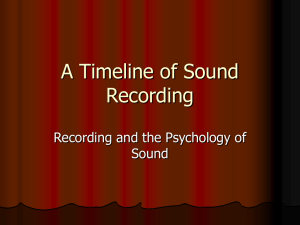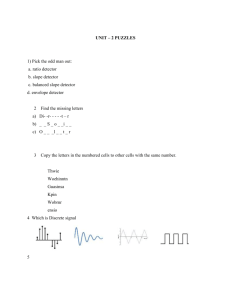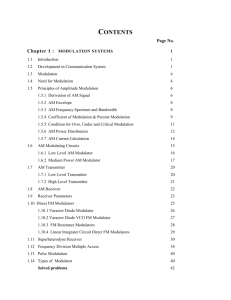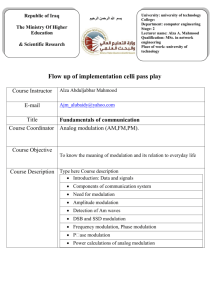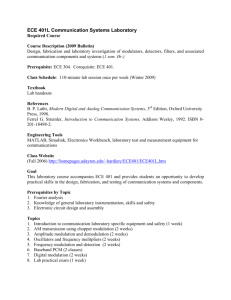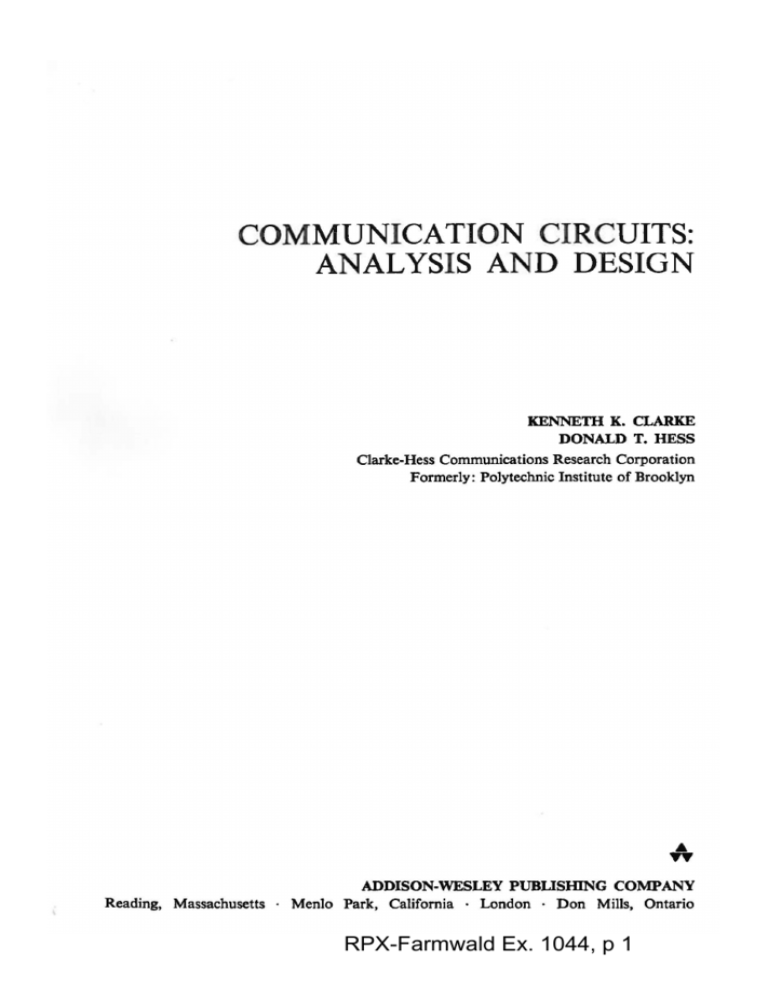
COMMUNICATION CIRCUITS:
ANALYSIS AND DESIGN
KENNETH K. CLARKE
DONALD T. HESS
Oarke-Hess Communications Research Corporation
Formerly: Polytechnic Institute of Brooklyn
ADDISON-WESLEY PUBLISHING COMPANY
Reading, Massachusetts · Menlo Park, California · London · Don Mills, Ontario
RPX-Farmwald Ex. 1044, p 1
This book is in the
ADDISON-WESLEY SERIES IN ELECTRICAL ENGINEERING
Consulting Editors
DAVID K. CHENG
LEONARD A. GOULD
FRED K. MANASSE
Copyright@ 1971 by Addison-Wesley Publishing Company, Inc.
Philippines copyright 1971 by Addison-Wesley Publishing Company, Inc.
All rights reserved. No part of this publication may be reproduced, stored in a retrieval system, or
transmitted, in any form or by any means, electronic, mechanical, photocopying, recording, or
otherwise, without the prior written permission of the publisher. Printed in the United States of
America. Published simultaneously in Canada. Library of Congress Catalog Card No. 78-125610.
RPX-Farmwald Ex. 1044, p 2
8.2
353
AMPLITUDE MODULATION TECHNIQUES
Even direct sideband filtering of suppressed carrier AM to produce SSB has its
practical limitations. It is a difficult matter to design a sideband filter which cuts
off sufficiently rapidly to attenuate one sideband while not distorting the other
sideband either in magnitude or in phase. For SSB voice modulation, mechanical,
crystal, or ceramic bandpass filters are usually employed to remove the undesired
sideband (See Fig. 7.6-1 for an example). Even though these filters have considerable
ripple in magnitude as well as significant nonlinearity in phase in the passband, their
effect on the intelligibility of average speech is negligible. For other forms of modulation the sideband filter usually has to be hand-tailored to the modulation to minimize
distortion. In all cases, however, the sharp cutoff required of the bandpass sideband
filter is possible only if the filter center frequency is not too high (the required Q of
the tuned circuits in the filter to maintain a fixed BW is directly proportional to w 0 ).
Consequently, in almost all SSB transmitters, the information is suppressed-carriermodulated at a reasonably low carrier frequency (50 kHz to 500 kHz for voice modulation) where sideband filtering is accomplished, and then the resultant SSB signal
is heterodyned to the desired carrier frequency w 0 •
In addition to the complications that SSB creates at the transmitter, its demodulation is possible only by synchronous detection, which requires a reference oscillator
at the radian frequency w0 • Since it is impossible to derive this frequency from the
SSB signal itself, a small pilot carrier is usually transmitted along with the SSB
signal to provide the reference at the receiver. The demodulation of SSB will be pursued in more detail in Chapter 10.
In the subsequent sections of this chapter we shall consider the theoretical
methods by which amplitude modulation (or multiplication of two signals) may be
accomplished. We shall then examine some practical circuits which implement the
theoretical methods.
8.2 AMPLITUDE MODULATION TECHNIQUES
In this section we investigate the theoretical methods by which we can multiply or
modulate cos w0 t by g(t) to obtain the AM signal
v{t) = g(t) cos Wot
= A[l
+ mf(t)] cos w 0 t.
(8.2-1)
In general, there are four basic methods by which amplitude modulation can be
accomplished :
a) analog multiplication,
b) chopper modulation,
c) nonlinear device modulation, and
d) direct tuned-circuit modulation.
As we shall see, all these methods can be employed to generate normal AM, whereas
only direct analog multiplication and chopper modulation can be employed to generate suppressed carrier AM. In addition, with the exception of the direct tunedcircuit modulator, modulation is accomplished at low power levels and amplified
RPX-Farmwald Ex. 1044, p 3
354
8.2
AMPLITUDE MODULATION
(class B-see Section 4.2 and 9.2) to the desired output level. The direct tuned-circuit
modulator directly modulates the amplitude of a high-power carrier which has been
amplified by more efficient class C amplifiers to the desired level.
Analog Modulation
Analog modulation (or multiplication) is accomplished in any device whose output
[v0 (t)] is directly proportional to two inputs [v 1(t) and v2 (t)], that is,
v0 (t) = Kv 1(t)v2(t).
(8.2-2)
Clearly, if v1(t) = cos <not and v 2(t) = g(t), then v0 (t) = Kg(t) cos w0 t, which is the
desired AM wave. In such devices no theoretical limitations exist; however, practical
device limitations usually impose limits on both the amplitude and frequency of
v1 (t), v2 (t), and v0 (t) in order to maintain the validity of Eq. (8.2-2).
Analog modulation can also be accomplished with two square-law devices as
Square-law device
v1+v2
V1(/)
+
-*
v,
Square-law device
V2(I)
v;= K 5v,2
V1 -V2
~
V4
v,
Fig. 8.2-1 Analog modulator constructed with two square-law devices.
shown in Fig. 8.2-1. In this system the output of the top square-law device, v3 , is
given by
v3 = Ks(vf
+ 2v 1v2 + v~);
(8.2-3)
the output of the bottom square-law device, v4 , is given by
v4 = Ks(vf - 2v 1 v2 + v~).
The system output v0 = v3
-
(8.2-4)
v4 is thus given by
v0 (t) = 4K 5 v 1(t)v 2(t),
(8.2-5)
which is the form of the output of an analog modulator.
If the square-law devices are "half square law" rather than full square law, i.e., if
(8.2-6)
then v1
+ v2 and v1
-
v2 must be constrained to be greater than zero to produce the
RPX-Farmwald Ex. 1044, p 4
8.2
355
AMPLITUDE MODULATION TECHNIQUES
desired output. Thus if v1 = A[l + mf(t)] and v2
modulation information (cf. Eq. 8.1-2), then
= V1 cos w 0 t,
where f(t) is the
A'
~
v0 (t)
= 4K5 ViA[1 + mf(t)] cos w 0 t,
(8.2-7)
provided that A(l - m) - Vi ~ 0 or equivalently
Vi1 -A'
m<
-
(8.2-8)
Since Vi > 0, we observe that, with half-square-law devices in the circuit of Fig.
8.2-1, the modulation index is constrained to be less than unity and thus the circuit
clearly cannot be used to generate suppressed carrier AM.
Even though the circuit does not produce a 100 % modulated AM wave (which
is desirable for efficient transmission), the modulation index at the output can be
increased by subtracting some of the excess carrier from the undermodulated signal.
This technique is referred to as carrier cancellation. For example, if we subtract
D cos w 0 t from v(t) = A[l + mf(t)] cos w 0 t, we obtain v0 (t) in the form
A'
v0 (t)
~[
m'
= (A - D) 1
J
+ Ar--;t;;"
_ DJ (t) COS w 0 t ,
(8.2-9)
from which it is apparent that we can increase the resultant modulation index m'
to unity by choosing D such that (A - D)/A = m or D/A = 1 - m.
Chopper Modulation
Chopper modulation is accomplished by chopping g(t) at the carrier frequency rate
and placing the resultant signal through a bandpass filter centered at the carrier
frequency. The basic skeleton circuit of the chopper modulator is shown in Fig.
8.2-2, in which the switch, which is controlled by cos w0 t, remains open for
A cos w 0 t ~ 0 and closed for A cos w 0 t < 0. To demonstrate that this circuit
accomplishes amplitude modulation, we first write v0 (t) in the form
V0 (t)
= g(t)S(t),
(8.2-10)
where S(t) is a switching function having the properties
S(t)
={ ~:
COS
COS
Wot ~ 0,
Wot< 0.
(8.2-11)
Clearly, then, S(t) is a square wave with unity amplitude which may be expanded in
a Fourier series of the form
S(t)
= -21 + -n2 cos w0 t -
2
- cos 3w0 t
3n
+ · ··
(8.2-12)
RPX-Farmwald Ex. 1044, p 5
356
8.2
AMPLITUDE MODULATION
R
+
+
V,,(I)
H(jw)
v.(I)
IA coswol I
"
CJ LI
(]
[
I
Fig. 8.2-2 Chopper modulator.
to yield
g(t) 2g(t)
2g(t)
(8.2-13)
+ -1t- cos w 0 t - -3n- cos 3w 0 t + · · · ·
2
From Eq. (8.2-13) we note that v0 (t) is the superposition of AM waves centered at
w 0 , 3w0 , 5w 0 , •••• If the bandpass filter H(jw) attenuates the low-frequency components of va(t) as well as the AM components of va(t) in the vicinity of 3w 0 , 5w 0 , ••• ,
then the output v0 (t) is given by
v (t) = a
(8.2-14)
where hdt) is the impulse response of the low-pass equivalent of the bandpass filter
and O(w 0 ) is the plane angle of H(jw) at w = ro 0 . If the low-pass equivalent filter is
RPX-Farmwald Ex. 1044, p 6
8.2
357
AMPLITUDE MODULATION TECHNIQUES
fiat over the band of frequencies occupied by g(t), then v0 (t) simplifies to the desired
form
(8.2-15)
where HL(jw) is the Fourier transform of hL(t).
Note that chopper modulation is possible only if the spectrum of the desired
AM wave does not overlap the spectra of any of the other components of va(t). A
typical sketch of IV.,(w)I, where V.,(w) is the Fourier transform of v.,(t), is presented in
lv.<w> I
IG<w- ~>I!
-..--...IG<w>I
3n """
w..
Wo
Wo - w..
I
1
3Wo
~ - w..
wo+w..
I
w-
3w 0 +w ..
Fig. 8.2-3 Spectrum of v0 (t).
Fig. 8.2-3 for the case where g(t) is band-limited to Wm. It is apparent from the figure
that, unless
(8.2-16)
then the spectra overlap and chopper modulation is impossible. In addition, the
closer Wm is to w 0 /2, the more complex the bandpass filter must be to effect the
frequency separation.
Note that no restriction has been placed on the modulation index of g(t); therefore, normal AM with a modulation index of unity as well as suppressed carrier AM
may be generated with the chopper modulator.
In order to relax the inequality of Eq. (8.2-16) and in turn make the design of
the filter H(jw) simpler, the single-pole voltage-controlled switch of Fig. 8.2-2 may
be replaced by the double-pole voltage-controlled reversing switch shown in Fig.
8.2-4. The reversing switch has the effect of making va(t) symmetrical about zero,
+
S'(t)
v.(I)
+
H(jw)
v,(I)
b'
1
j cos w0 1 j
Fig. 8.2-4 Balanced chopper modulator.
RPX-Farmwald Ex. 1044, p 7
358
8.2
AMPLITUDE MODULATION
thus eliminating the low-frequency component of v0 (t). Consequently, with the
chopper modulator of Fig. 8.2-4, modulation is possible if
(8.2-17)
Equation (8.2-17) ensures that the spectra of the desired AM wave centered at w 0
and the AM wave centered at 3w0 do not overlap.
On a rigorous basis we observe that for the balanced chopper modulator of Fig.
8.2-4
v0 (t) = g(t)S'(t)
(8.2-18)
where
S'(t) = {
COS
l,
-1,
COS
Wot 2:: 0,
Wot< 0.
(8.2-19)
Since S'(t) is a square wave with a peak-to-peak amplitude of 2 and zero average
value, S'(t) may be expanded in a Fourier series of the form
S'(t) =
~cos
w0 t 1t
4
cos 3w0 t
31t
+ · · ·.
(8.2-20)
Hence
va(t)
=
4g(t)
4g(t)
--cos w 0 t - - - cos 3w0 t + · · ·,
1t
31t
(8.2- 21)
which, as expected, has no low-frequency component. Equation (8.2-21) also
indicates that the reversing switch permits us to obtain twice as much output from
the modulator of Fig. 8.2-4 as from the modulator of Fig. 8.2-2.
In many practical cases the switch S(t) in the chopper modulator of Fig. 8.2-2
has a resistance r in series with it which prevents complete attenuation of g(t) when
S(t) is closed. Consequently, v0 (t) is switched between g(t) and rg(t)/(r + R) in lieu
of g(t) and 0. This may be expressed mathematically as
V0 ( t )
=
(
gt
)S( ) g(t)[l - S(t)]r
t +
R .
r+
It is apparent that the fundamental component of v0 (t) is given by
2g(t)( 1 - _r_) cos w t = 2g(t) ~cos Wot,
0
r+R
1t
1t
and in tum v0 (t) is given by
v0 (t)
=
[ 2~t) * hL(t)J
R:
R+r
r cos [wot
+ O(wo)].
(8.2-22)
(8.2-23)
(8.2-24)
Thus we see that the only effect of the series resistance r is to attenuate the output
by the factor R/(R + r). If r = R, the output level is reduced by a factor of 2.
RPX-Farmwald Ex. 1044, p 8
8.2
359
AMPLITUDE MODULATION TECHNIQUES
Nonlinear Device Modulation
Nonlinear device modulation is accomplished by summing the modulation and the
carrier, applying them to a nonlinear device, and then passing the device output
through a bandpass filter centered at ro 0 to extract the desired AM signal. A block
diagram of a nonlinear device modulator is shown in Fig. 8.2-5. As we shall see, the
nonlinear device modulator has more restrictions for its proper operation than any
IH(jw)I
Wo
v1(t)=g(t)=A[I +m/(t))
w-
: :¢ ~ I~ Ji-----1~
V2(t)= V1 COSWQI
Fig. 8.2-S Block diagram of nonlinear modulator.
of the previously considered modulators. First of all the nonlinear device must have
no greater than a second-order (square-law) nonlinearity. Second, the maximum
modulation frequency Wm must be less than ro 0 /3; and third, if the nonlinear device
contains a "half-square-law" term, 100 % modulation or suppressed carrier modulation is not possible.
To determine the reason for these restrictions as well as an expression for the
output signal v0 (t), let us first express the output of the nonlinear device va(t) in the
form of a MacLauren series,
where
(8.2-25)
With
V;
= v1
+ v2 , Va reduces to
(8.2-26)
A little thought indicates that, if V2(t) = Vi cos root and V1(t) = g(t), the following
components of Va (as well as a number of other components) have frequency spectra
RPX-Farmwald Ex. 1044, p 9
376
8.4
AMPLITUDE MODULATION
8.4 PRACTICAL CHOPPER MODULATORS
The key component in a chopper modulator is the voltage-controlled switch which
opens and closes at the carrier rate. Therefore, in this section we shall look at two
voltage-controlled single-pole single-throw (SPST) switches-one employing a
diode bridge and the other employing a single FET-and then we shall consider the
problem of employing these single-pole switches to construct a voltage-controlled
reversing switch. The SPST switch is used in the single-ended chopper modulator
shown in Fig. 8.2-2, whereas the reversing switch is employed in the balanced chopper
modulator shown in Fig. 8.2-4.
Note that, although the voltage-controlled switch is being discussed in conjunction with chopper modulators, it functions equally well as a synchronous demodulator or a mixer in the same configuration as Fig. 8.2-2. For a synchronous
detector, however, the output filter must be replaced by a low-pass filter, whereas
for a mixer the output bandpass filter must be tuned to the intermediate frequency.
Diode-Bridge Modulator
Almost all single-ended chopper modulators in use today employ the diode bridge
as the voltage-controlled switch. Figure 8.4-1 illustrates a typical diode-bridge
modulator in which a positive value of v1 (t) causes all the bridge diodes to conduct
thereby bringing v0 (t) close to ground potential, and in which a negative value of v 1
reverse-biases all the bridge diodes, thereby permitting va(t) to follow g(t).
It is apparent that the amplitude Vi of v1(t) must be sufficiently large when v1
is negative to keep all the diodes reverse-biased. A little thought indicates that for
g(t) ;;::: 0, and with v1 (t) = - Vi, D2 and D3 are on the verge of conduction when
g(t) = Vi + 2V0 ; and that for g(t) < 0, D 1 and D4 are on the verge of conduction for
jg(t)I = V1 + 2V0 • Hence to ensure that all the bridge diodes remain reverse-biased
for v1 = - V1 , we require that
Vi >
g(t) - 2V0
(8.4-1)
for all t.
It is also apparent that Vi must be sufficiently large when v 1 = +Vi to keep all
the diodes forward-biased so that the bridge presents a low impedance to ground;
that is, v0 (t) should be a small voltage with v 1 = Vi. To determine the required magnitude of V1 in this case, we define the current leaving the v1 source as I 2 and the current
leaving the g(t) source as i 1{t). Since, in general, the four bridge diodes are integrated
on a single chip with identical geometries, the bridge is balanced and i 1 (t) and / 2
split equally between the two bridge arms; thus
·
.
12 - i 1(t).
ID1(t) =
= ID4(t),
2
(8.4-2)
RPX-Farmwald Ex. 1044, p 10
8.4
377
PRACTICAL CHOPPER MODULATORS
x
~
+
g(t)
+
+
Vo,
D3
'V
v.
g,.v.
t
RL
L
c
v.(t)
D4
~
Wo
V1(t)
2n
Wo
Fig. 8.4-1 Chopper modulator employing diode bridge.
If we assume that each diode is characterized by the volt-ampere relationship
(8.4-3)
then
_
Va -
_
Vv2
_ kT(l 12
Vv1 -
q
n
+ i 1 (t)
2/s
l / 2 - i 1 (t))
n
2ls
(8.4-4)
= kT ln (1 + i 1(t)// 2 )·
q
1 - i1(t)//2
By expanding v0 (t) in a MacLauren series in i 1// 2 , we obtain
va(t) = r
4i1( 1 + ;;~ + ;J1 + · · · ).
(8.4-5)
where r 4 = (kT/q)(2/I 2 ) is the small-signal diode resistance with I 2 /2 as a bias current.
It is apparent that, if we wish to keep nonlinear components ofi 1 [which is proportional to the modulation g(t)] out of the output to avoid envelope distortion in v0 (t),
then iV31~ « 1. With this restriction v0 (t) = r 4i 1(t) and the forward-biased diode
RPX-Farmwald Ex. 1044, p 11
378
8.4
AMPLITUDE MODULATION
bridge may be modeled as a single resistor of value rd shunting v0 ; hence the diode
bridge takes the form of an ideal voltage-controlled switch in series with a resistance
With this model
while
_
I 2-
Vi -
2V0
R2
and
r d -
q(Vi
2R 2
.
- 2V0 )/kT'
thus to keep ii/31~ < 0.01,
(8.4--0)
for all t. The inequalities of Eqs. (8.4-1) and (8.4-6) may be satisfied simultaneously
by choosing Vi > g(t) - 2V0 and choosing R 2 of the order of -foRi. For example,
if lg(t)lmax = 10 V, then the bridge remains open with Vi = - Vi for Vi > 8.5 V
(V0 = i V). If we select Vi = 9 V, then if
R - Ri +rd
R1
2
7.75 ~ 7.75'
-
.
the bridge appears as a resistor rd with v 1 = Vi.
A complete diode-bridge modulator which incorporates the floating source
vi (t) as well as the output filter is shown in Fig. 8.4-2. In this circuit the transformer
c
L
~
.
+
lc = alc
v (t)
0
l
- v,;£
Fig. 8.4--2 Practical balanced modulator.
RPX-Farmwald Ex. 1044, p 12
8.4
379
PRACTICAL CHOPPER MODULATORS
is a closely coupled transformer operating in its midband range, and therefore
functions as an ideal transformer. In addition, (1 + f3)RE is large in comparison with
R 1 so that the transistor does not load the bridge. Consequently, if the output-tuned
circuit is broad enough to pass the modulation and yet narrow enough to remove the
low-frequency and higher-harmonic components of v0 (t), then from Eq. (8.2-19)
2g(t) R 1
Vo(t) = -R R
1t
E
I
+rd
cos Wot
+ Vee·
(8.4-7)
Equation (8.4-7) assumes, of course, that Eqs. (8.4-1) and (8.4--6) have been satisfied
and that the transistor remains in its active region.
The control voltage v1 (t) may be supplied by a sufficiently large sine wave of
radian frequency w 0 instead of a square wave. If, as shown in Fig. 8.4-3, Vi is large
in comparison with V,. and Vp (Eqs. 8.4-1 and 8.4-6), then the sine wave functions in
essentially the same fashion as the square wave in controlling the states of the bridge.
Switch
open
V.
jg(t) j..,.,- 2 V0 ......__--+--+--1r----+-------+----
Fig. 8.4-3 Sinusoidal control voltage.
One main advantage of a sine-wave drive is that the transformer coupling v1(t)
to the diode bridge need not be nearly as broadband. On the other hand, the larger
value of Vi with a sine-wave drive requires a much higher breakdown voltage for the
bridge diodes.
Whether v1(t) is a sine wave or a square wave, in practical diode bridges shortduration transient "spikes" appear on v0 (t) in the vicinity of the bridge transitions
from open to closed because of parasitic capacitance and diode charge storage. These
spikes are, in general, of little consequence, since they contain sufficiently highfrequency components so that they are not transmitted to the output through the
bandpass filter H(jw).
FET Modulator
A junction or an insulated-gate FET may be employed instead of the diode bridge
as the voltage-controlled switch in a chopper modulator. Figure 8.4-4 illustrates a
RPX-Farmwald Ex. 1044, p 13
380
8.4
AMPLITUDE MODULATION
2n
V1(I)
w
L
- Vi
O+P)R£»R1
+
Ri
v.
+
g(t)
1
D
+
G
rv
v.(t)
s
V1(t)
Fig. 8.4-4 N-channel junction FET chopper modulator.
typical N-channel junction FET chopper modulator. In this circuit, with v1(t) =
- Vi < Vp (Vp is the pinch-off voltage of the FET), the FET opens, permitting v0 (t)
to follow g(t). On the other hand, with v1(t) = 0, then the FET functions as an ohmic
conductance gDss of value
- 21DSS(1 -Vas)
gDss--- Vp
Vp vas=o
21Dss
-
Vp'
(8.4-8)
provided that lvDsl = lv0 I < lOOmV. Consequently the FET may be modeled as an
ideal voltage-controlled switch in series with a resistance rDss = 1/gDss· For typical
junction and insulated-gate FET's, rDss varies from several ohms to several thousand
ohms.
With V1(t) = 0,
_
_ g(t)rDSS .
Va(t) - VDs ,
Ri + rDss
thus to ensure that lvDs(t)I remains less than 100 mV for all t we require R 1 to be
sufficiently large so that
lg(t~max R 1 > rDSS ( lOOmV
1) .
(8.4-9)
For example, if lg(t~max = 5 V and rDss = 500 n, then R 1 > 24.5 kn To avoid
loading by the output transistor when the FET is reverse biased, the resistor R 1
RPX-Farmwald Ex. 1044, p 14
8.4
381
PRACTICAL CHOPPER MODULATORS
should not be chosen too much greater than this value. If, on the other hand, Rt
is chosen to be less than 24.5 kll, then va(t) exceeds 100-mV, r 0 ss becomes nonlinear,
and v0 (t) is no longer a linear function of g(t); consequently nonlinear envelope distortion begins to appear on the output AM wave.
If RE is sufficiently large so that transistor loading can be neglected, then v0 (t) is
given by (cf. Eq. 8.4-7)
2g(t)
Rt
v0 (t) = -R R
7t
E
1
+ rDSS
cos w0 (t)
+ Vee·
(8.4-10)
However, if RF. is not sufficiently large, then the loading must be incorporated with
the g(t)-R 1 network as shown in Fig. 8.4-5 by forming a Thevenin equivalent network. Clearly g(t) is decreased by a factor of 'I because of the loading; however, in
addition, a de bias V' is added in series with g(t). If g(t) = 0, as it is for suppressed
carrier modulation, then the presence of V' produces an average component in the
modulation voltage being chopped and thus a nonzero carrier at the output. To
eliminate this undesired carrier component, either RE must be increased relative to
Rt or an isolation stage such as a source follower must be inserted between the
chopper stage and the output transistor.
R]
v-------aa
+
'"\,
a
-
g(t)
Ji;E -Vo
'----------oa'
n
=
(l+IJ)R£
(I+ P>RE+ R1
• V'= o~E - Vo)R1' R] = R1 !1 (l
(I+ P>Rc+ R1
a'
P>RE
Fig. 8.4-5 Effect of transistor loading.
In addition to the diode bridge or the FET chopper, a bipolar transistor being
switched between saturation and cutoff may be employed as the voltage-controlled
switch. However, when saturated, the transistor may be modeled as a resistor in
series with a de voltage source of approximately 100 m V (for silicon). This voltage
source has the effect of introducing a carrier component at the modulator output,
which is quite undesirable if suppressed carrier AM is being generated. This saturation
voltage may be largely balanced out by placing two transistors in series (emitter to
emitter) and placing the switching voltage between their bases.
RPX-Farmwald Ex. 1044, p 15
382
8.4
AMPLITUDE MODULATION
Balanced Chopper Modulator
Figure 8.4---6 indicates how two diode bridges can be employed to alternately apply
+ g(t) and - g(t) across R 1 and thus produce the effect of a reversing switch. Note
that the bridges are arranged so that one bridge is open when the other is closed. It
is apparent that the closed bridge is unaffected by the open bridge and thus Eq.
(8.4-6) still determines the value of Vi required to ensure that the bridge remains
,_
2n
Wo
Fig. 8.4--6 Reversing switch for balanced chopper modulator.
closed for all t. On the other hand, the closed bridge does affect the open bridge in
that it increases the voltage across the open bridge to
g(t)(l
+R
Ri );
1 +rd
hence with the arguments employed to obtain Eq. (8.4-1) we require
Vi >
g(t)(l
+R
Ri ) - 2V0
1 +rd
(8:4-11)
for all t to ensure that all the diodes in the open bridge remain reverse biased.
Figure 8.4-7 illustrates a practical chopper modulator in which both g(t) and
v1(t) are supplied from grounded sources. The transformer T1 is a closely coupled
center-tapped audio transformer with a midband frequency range sufficient to pass
the frequency components of g(t) (see Section 2.2), while the transformer T2 uses a
RPX-Farmwald Ex. 1044, p 16
8.4
383
PRACTICAL CHOPPER MODULATORS
v.
c
L
ic-......;;:_
J_
J{c
Fig. 8.4-7 Practical balanced chopper modulator.
closely coupled transformer with a midband capable of passing the main frequency
components of v1(t). If v1(t) is a large-amplitude sine wave, then the restrictions on
T2 are nominal. [Although unity turns ratios are indicated for the two transformers,
other turns ratios merely introduce a scale-factor change in g(t) and v1(t).] If we
assume that R 1 is not loaded by the transistor and that Eqs. (8.4-6) and (8.4-11) are
satisfied, then v0{t) may be expressed as
(8.4-12)
where S'(t) is given by Eq. (8.2-19). And if we assume that the transistor does not
saturate, we may write
RPX-Farmwald Ex. 1044, p 17
384
8.5
AMPLITUDE MODULATION
and in turn
(8.4-13)
where z 11 L(t) is the low-pass equivalent impulse response of the output parallel RLC
circuit. If the output filter passes g(t) undistorted while removing the 3w 0 component
of v0 (t), then v0 (t) reduces to the desired form
4cxRL
vo(t) = Vee - - -
R1
ttRE R 1 +rd
g(t) cos Wot.
(8.4-14)
8.5 SQUARE-LAW MODULATOR
The square-law device, although quite attractive as a mixer, finds very little application
as an amplitude modulator. The basic reason for this is that most physical devices
have half-square-law characteristics rather than full-square-law characteristics. As
we saw in Section 8.2, unless a full-square-law characteristic exists, not only is suppressed carrier modulation impossible but also normal AM with 100% modulation
is impossible. Consequently, unless a "quick and dirty" low-index modulator will
satisfy the requirements of the situation, the other modulators discussed in this
chapter are usually employed. Therefore, we shall look only briefly at one squarelaw modulator constructed with a junction FET operating within its saturation region.
A typical square-law FET modulator is shown in Fig. 8.5-1. If for this circuit
we assume that the FET operates within its saturation (square-law) region and that
RL is much less than the output impedance of the FET, then we may approximate
the drain current as
iD = IDss( 1 - v;:)2.
(8.5-1)
where Vp is the pinch-off voltage and I Dss is the drain current with vGs = 0 and
vDs = - Vp. For the bias arrangement shown in Fig. 8.5-1, iD reduces to
2
. ( ) _ I (Vi + V2) _ I
ID t - DSS
Vp
- DSS
{Vi cos w 0t +VpA[l + mf(t)]) 2.
(8.5-2)
Since the component of iD(t) centered about w 0 is
21DssViA
V/
[1
+ mf(t)] cos w 0 t,
then with the assumption that the output filter removes the low-frequency and secondharmonic components of iD, v0 (t) is given by
Vo(t) = VDD -
21DssViA
v~
[1
+ mf(t)]. z llL(t) cos Wot.
RPX-Farmwald Ex. 1044, p 18
(8.5-3)
8.5
385
SQUARE-LAW MODULATOR
c
L
Y,.
+
~ io
l'Gs~
v. = vos
l
+
i0 =loss(l-
~)2
-
-
V2 = A[I
_ 1 ( v1 + v2)2
DSS
Y,.
m/(t))
-
IV, !
I
V1 = Jl1 COSWQI
Wo =
vie-
Fig. 8.S-1 FET square-law modulator.
If, in addition, the output filter is fiat over the band of frequencies occupied by the
AM signal, v0 (t) simplifies to the desired form
V0 (t) = VDD -
21DssViARL
V~
(1
+ mf(t)] COS Wot.
(8.5-4)
To realize v0 (t) in the form ofEq. (8.5-4) we must restrict v0 (t) > -I Vpl for all time
to ensure that operation remains within the saturation region. This may be accomplished for any FET parameters by choosing a sufficiently small value of RL .
In addition,
for all time to keep the FET from being cut off and
for all time to keep the gate-to-source diode from turning on. These two restrictions
RPX-Farmwald Ex. 1044, p 19

